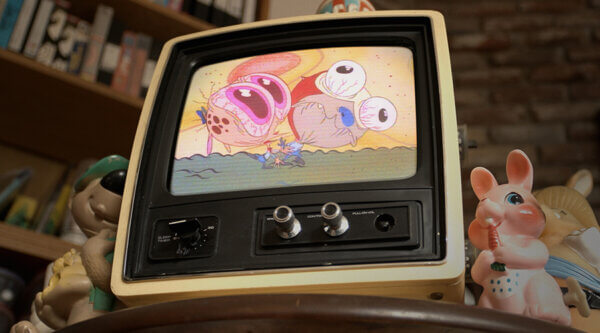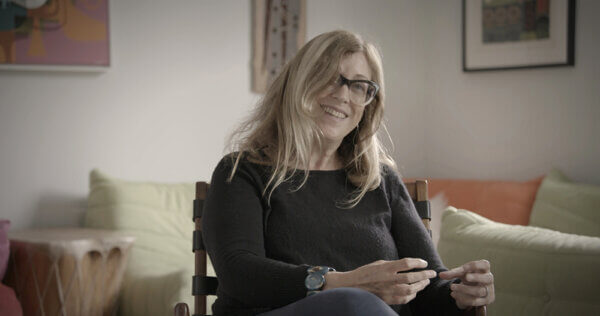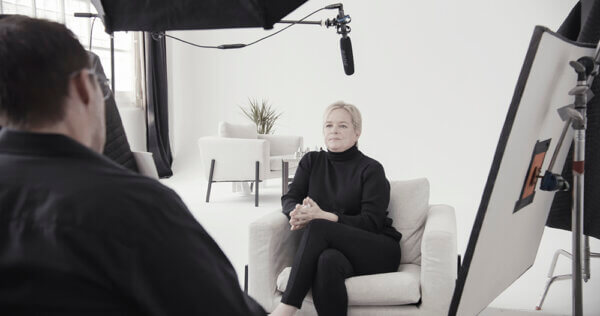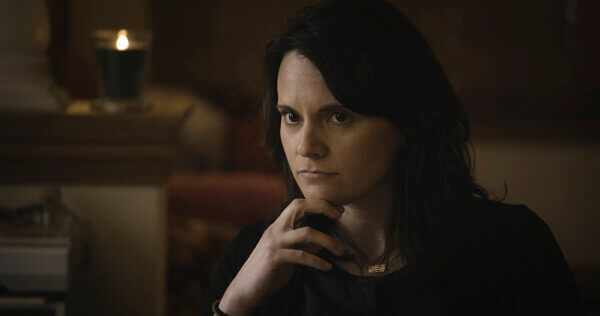Review: ‘Happy Happy Joy Joy – The Ren & Stimpy Story’

Happy Happy Joy Joy: The Ren & Stimpy Story (Image: INVADER)
It’s no secret to regular Skwigly readers and listeners that The Ren and Stimpy Show was something I held quite dear to my heart. Although its entertainment value had long since diminished due to personal overexposure and, frankly, the evolution of comedy in general over the past 30 years, its enduring influence and game-changing artistry can be seen across animated series production to this day. Granted, from the schoolyards to the uni bars it was never an easy sell – said artistry would often centre around, say, the intricate placement of hairs and skin flakes on a needless close-up of a glob of earwax, or exposed nerves being tweezed out of open gumholes – but most could begrudgingly get behind its status as a contemporary animation phenomenon.
Notoriously, it of course ranks as one of the most troubled animated series in history, steeped in gossip and scandal with the eschewed John Kricfalusi its martyred figurehead for the decades that followed – a creator being fired from his own show! The mind boggles.
The appeal of gossip and hearsay being what it is, it’s perhaps not surprising that there have only been a couple of stabs at impartially documenting these troubles from all angles, the most recent being last year’s Happy Happy Joy Joy: The Ren & Stimpy Story from directors Ron Cicero and Kimo Easterwood, released this week in the UK.
From the outset there is an enormous amount to like. To finally hear direct, on-camera insights from the likes of co-creator Bob Camp (who took on the thankless task of running the show after Kricfalusi’s dismissal), Lynne Naylor, Richard Pursel, Bob Jaques, Scott Wills, Bill Wray, Elinor Blake, Ed Bell, Vincent Waller and the late Chris Reccardi constitutes something of a holy grail to animation fans. Many of the contributors are people for whom the subject is not merely sore, but emotionally excruciating (in my own personal correspondences with some of these artists the word ‘traumatised’ without exaggeration or irony has been used more than once), so to have created a space for them comfortable enough to share their experiences would have been no mean feat.
As a film it holds together very well considering the various spanners thrown in the works along the way that forced the directors to rebuild a significant percentage of it (more on that later). The elements that remain from what one assumes was their original idea for the doc are perhaps the strongest. Those who weren’t there at the time will appreciate the pains that have been made to capture the sheer fascination the press had with the show and the mania whipped up around it through amassed clips and cuttings. The stories of what went on within the walls of the studio – chaos, for the most part – are compellingly woven together with in-studio footage, much of which previously unseen, and it’s a genuine joy to be presented with analyses and breakdowns of some of the show’s most iconic sequences alongside storyboards and animatics.

Lynne Naylor (Image: INVADER)
The turmoil of the show is also well represented; a picture is painted of artists at the top of their game tested to their absolute limits by autocratic management. The specific episodes Stimpy’s Invention and Man’s Best Friend are focused on for the roles their production would play in Kricfalusi’s downward spiral toward eventual dismissal.
In that respect this documentary shines a pretty clear light on how his destructive behaviour patterns, categorised by himself and his acolytes as extreme perfectionism, have always been with him. In hindsight it’s more of a surprise that certain post-Ren and Stimpy projects, such as his various music videos and a trifecta of modern Yogi Bear shorts that all genuinely have decent moments, actually reached the finish line. As presented in the film, the extremes of his stubbornness to not concede in any respect whatsoever flagrantly disregards the realities of production, economics and expectations of adult comportment. That his doomed Ren and Stimpy revival Adult Party Cartoon and various other projects would crash and burn in such a similar manner – and for such similar reasons – decades later certainly indicates that no lessons were ever learned.
There is a lot of welcome clarification the film offers up. Certainly it is Executive Producer Vanessa Coffey whose battle scars can be worn with the most pride as someone who, despite securing the show’s existence in the first place, was doomed to perpetually live in the uncomfortable, ever-narrowing gap between rock and hard place through its most tumultuous years. You don’t get the sense that anybody involved feels remotely victorious, however – to finally get some vindication after so many years of their intentions and efforts being demonised and misrepresented is palpably bittersweet.

Ron Cicero and Vanessa Coffey (Image: INVADER)
The major criticisms of the first part of the doc, which I’m sure the filmmakers are pre-emptively weary of, are largely of what is skimmed over, or left out altogether. Of course anyone who knows anything about documentary features is aware that the decisions regarding what to include and exclude are severely shackled by the film’s running time and can often be heartbreaking. With that in mind, it remains a bit of a head-scratcher that we spend as much time as we do on an avid merchandise collector or the smattering of redundant observations from celebrity fans outside of the animation sphere when we could be spending it focused on the unparalleled talents of the likes of Billy West or Bill Wray. Several other key players in the Ren and Stimpy saga, such as Eddie Fitzgerald, make what could constitute as cameos, while the work of the show’s strongest animators Bob Jaques and Kelly Armstrong seem to warrant no discernible mention. The real shame is that the show’s hugely underappreciated post-Kricfalusi, Bob Camp-helmed Games era, easily the most directly influential on the landscape of television animation that succeeded it, barely gets a look in. If there was one opportunity for such an unfairly maligned and notoriously misrepresented chunk of the show’s history to be given its deserved day in court, this surely could have been it (by the same token, however, the eventual collapse of the show and the swiftness of its decline during its fifth and final Nickelodeon season gets off scot-free).
Instead the film shifts, with some unavoidable clunkiness, to the least palatable aspect of Kricfalusi’s legacy, chiefly his penchant for underage girls and the instances in which he has acted on it. As the revelations came out while the film was initially wrapping up production, the directors made an executive decision to rethink and rework what it was they wanted to achieve with it. It’s an understandable challenge to have the premise of your documentary change from a fun, Disaster Artist-esque portrait of a troubled cartoon to an explication of very serious instances of habitual abuse. All of a sudden we’re in territory more reminiscent of Louis Theroux: Savile or Abducted in Plain Sight, and the anecdotes about Kricfalusi’s wacky, expletive-laden admonishments are given a darker tinge; this wasn’t just some goofabout who lost his head from time to time to the bafflement and occasional hurt feelings of his crew but something far more pernicious, toxic and abusive.

Robyn Byrd (Image: INVADER)
In previous reviews and posts from those who had seen Happy Happy Joy Joy prior there have been criticisms of the film’s handling of Kricfalusi himself, chiefly that they don’t give him nearly enough of a grilling. As a viewer it’s especially rage-inducing to sit through such coy, glib admissions as “she was so convincing” when attempting to recategorise his preying on a 14-year-old girl as some sort of seduction she’d initiated. That the interviewers seem to have held back is difficult to watch on an emotional level, but the long game pays off insofar as it is Kricfalusi himself who effectively holds his own feet to the fire. We sit through various woe-is-me tales that shift blame and accountability onto various players in his professional and personal life – Bob Camp, Vanessa Coffey, his own father – but as dressed up as they may be, his sins are confessed, and anyone with emotional intelligence can see the rationalisations that accompany them for what they truly are.
But therein lies the problem – that there is a worrying dearth of emotional intelligence among what remains of his fanbase, and there’s no onus on the filmmakers to spell it out more explicitly than they have done. That they took the opportunity to expand on it in whatever way they could is encouraging, for several reasons – while widely circulated, the original Buzzfeed piece that laid it all out there hasn’t lingered in public consciousness nearly enough and, in spite of his self-described forced retirement, Kricfalusi has again started blogging and posting to Instagram. Among his nearly 12k re-amassed followers making the effort to like and share his posts are some disconcerting mutuals, including a director known for films about sexual harassment as well as an organiser of events and initiatives specifically designed to support and lift up the female animation community – not to mention the many men from a variety of animation fields who purport to be allies to women. If this is a representation of people who still admire what he has to bring to the table then more work needs to be done; hopefully this film will open the eyes of those who turned away the first time. As to whether it has handled the material with enough sensitivity and regard for the people who were hurt, it feels inappropriate from my position to speculate (the response from victims has ranged from ambivalent praise to disappointment).

Chris Reccardi (Image: INVADER)
As several others have pointed out, the sheer wealth of material generated by this bizarre aberration of a TV series could easily stretch into a docuseries of its own – in a world where Ren and Stimpy weren’t, to quote Rich Pursel (quoting Vincent Waller), “covered in shit paint”. But that, unfortunately, remains the problem – they are. Inevitably there would never have been a single film that served as a fully comprehensive overview of the production of this show (at the time of writing Thad Komorowski’s Sick Little Monkeys remains the most thorough overview in that regard), nor would any exposé of the awfulness directly and indirectly linked to it have felt comprehensive enough. In that respect it’s a film doomed to leave you wanting more, which at the end of the day is far from a criticism. Objectively speaking, Happy Happy Joy Joy is a notably strong debut film in terms of its technical sophistication and emotional engagement; certainly it warrants recommendation as an accessible and often entertaining port of call for those curious about the topic.
The future of The Ren and Stimpy Show is uncertain – nobody seems to know for sure if a reboot proposed last year is still on the cards, and nobody seems to want it either way – but should this film turn out to represent the last hurrah for the duo as we knew them, then it’s as gracious a sendoff as they can hope for.
Happy Happy Joy Joy: The Ren & Stimpy Story is available in the UK via iTunes, Amazon and Google+ on January 22nd

